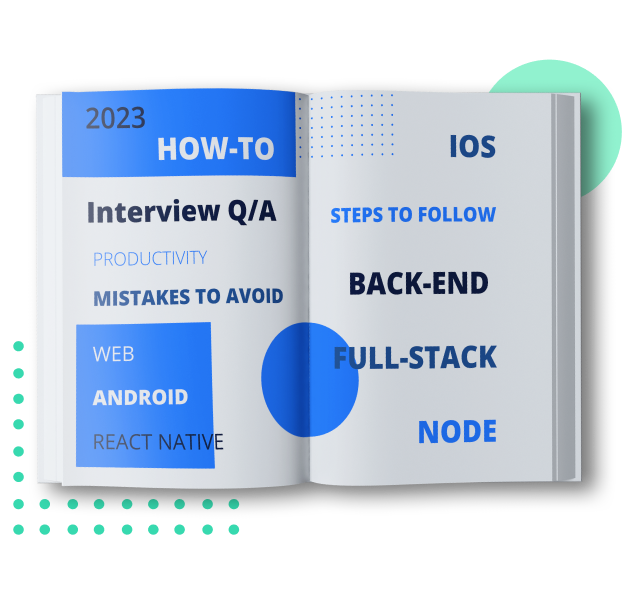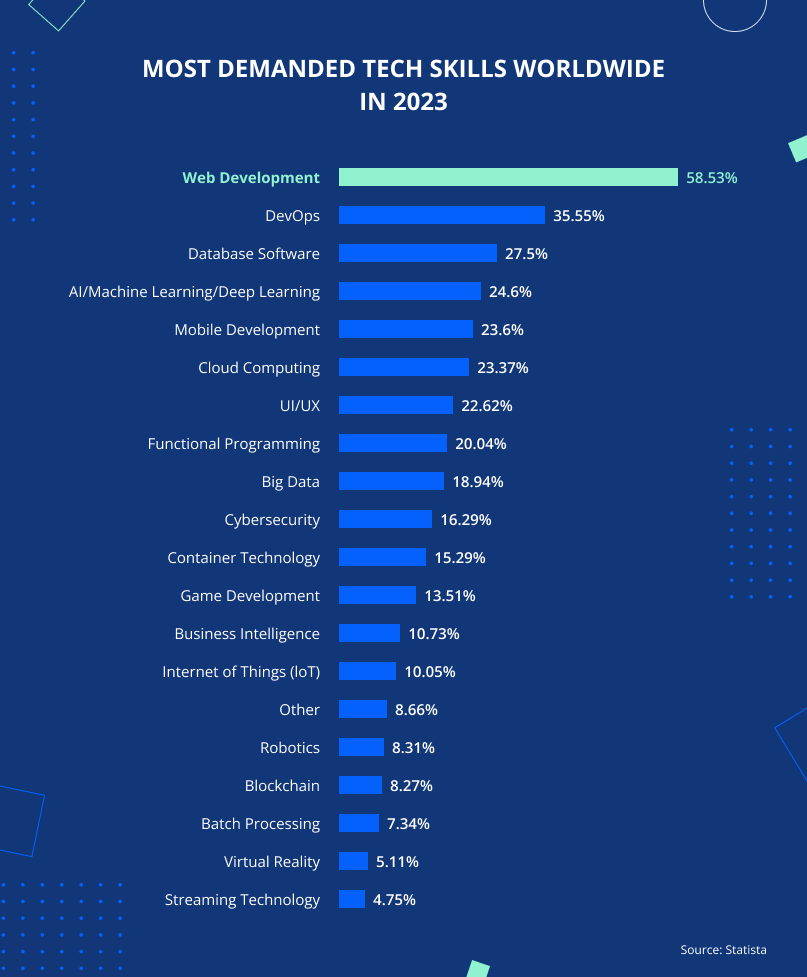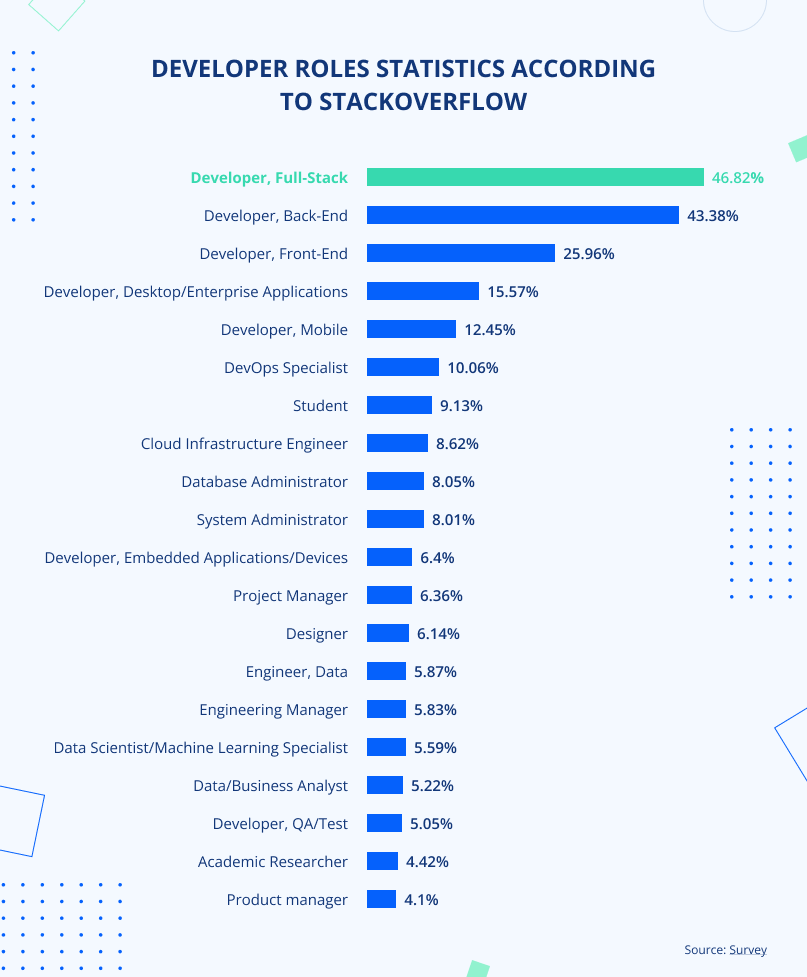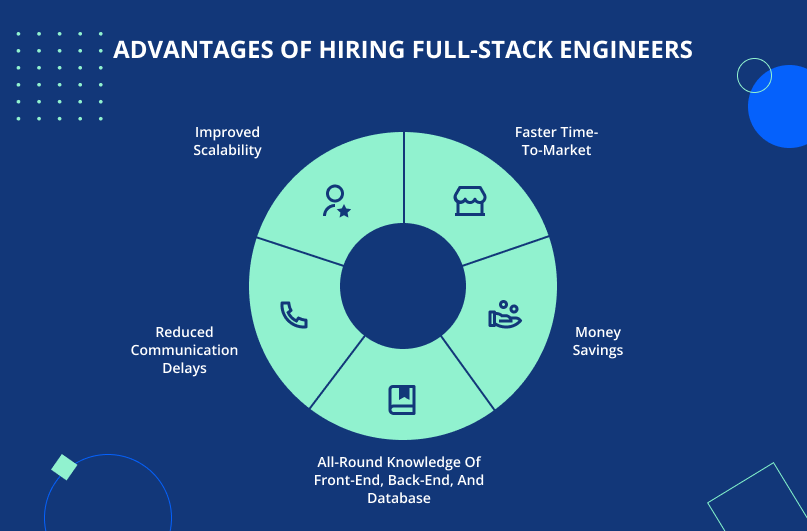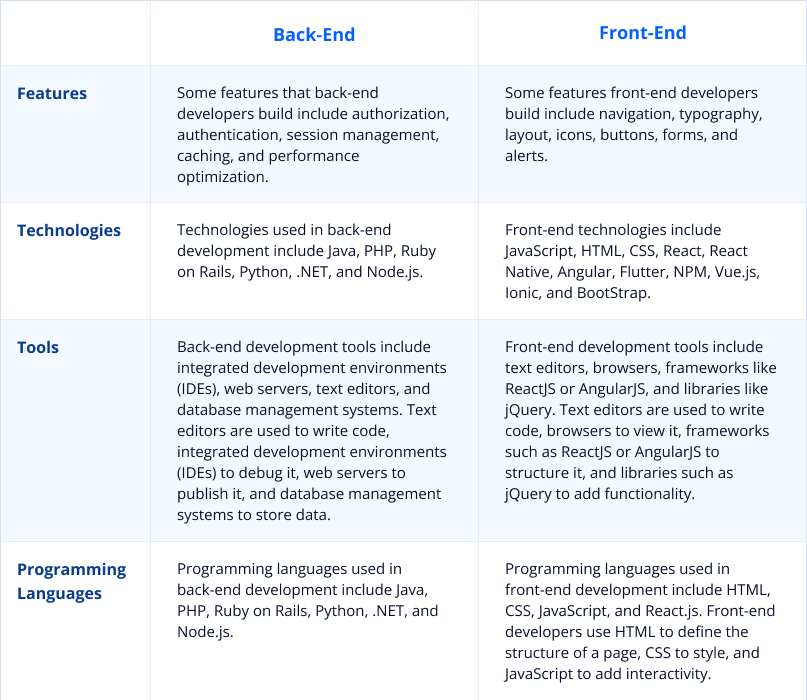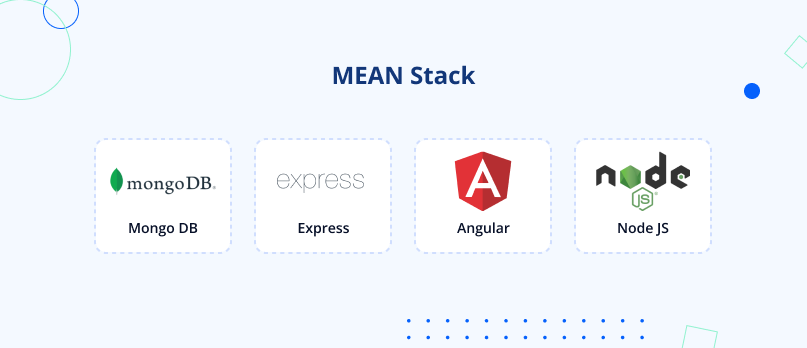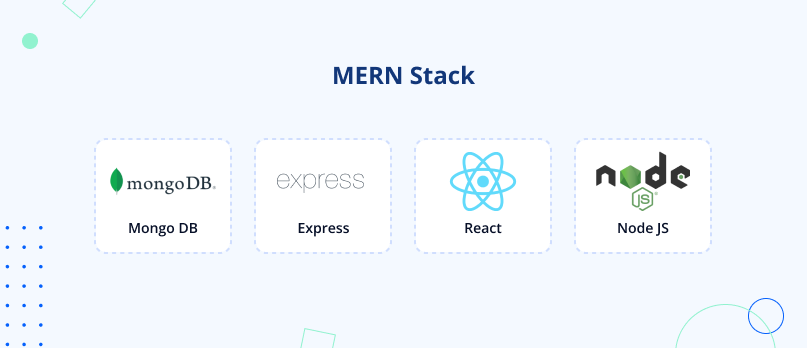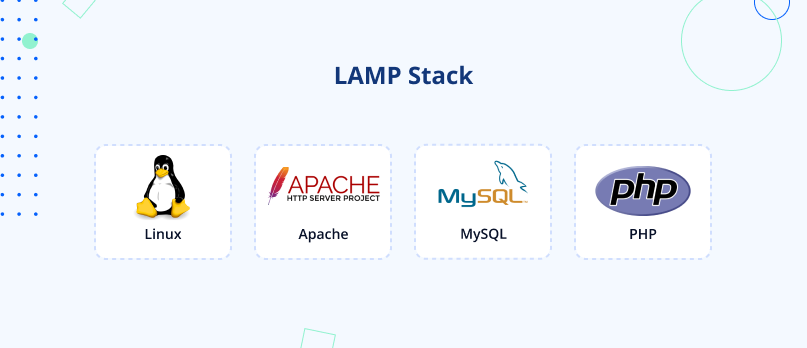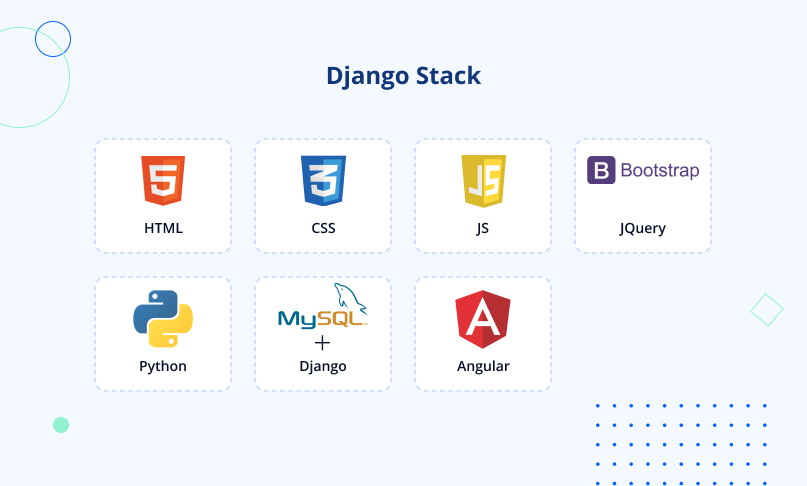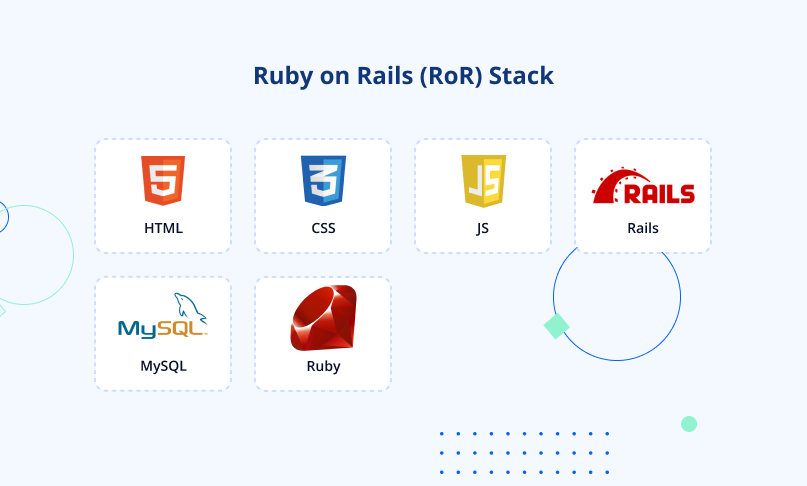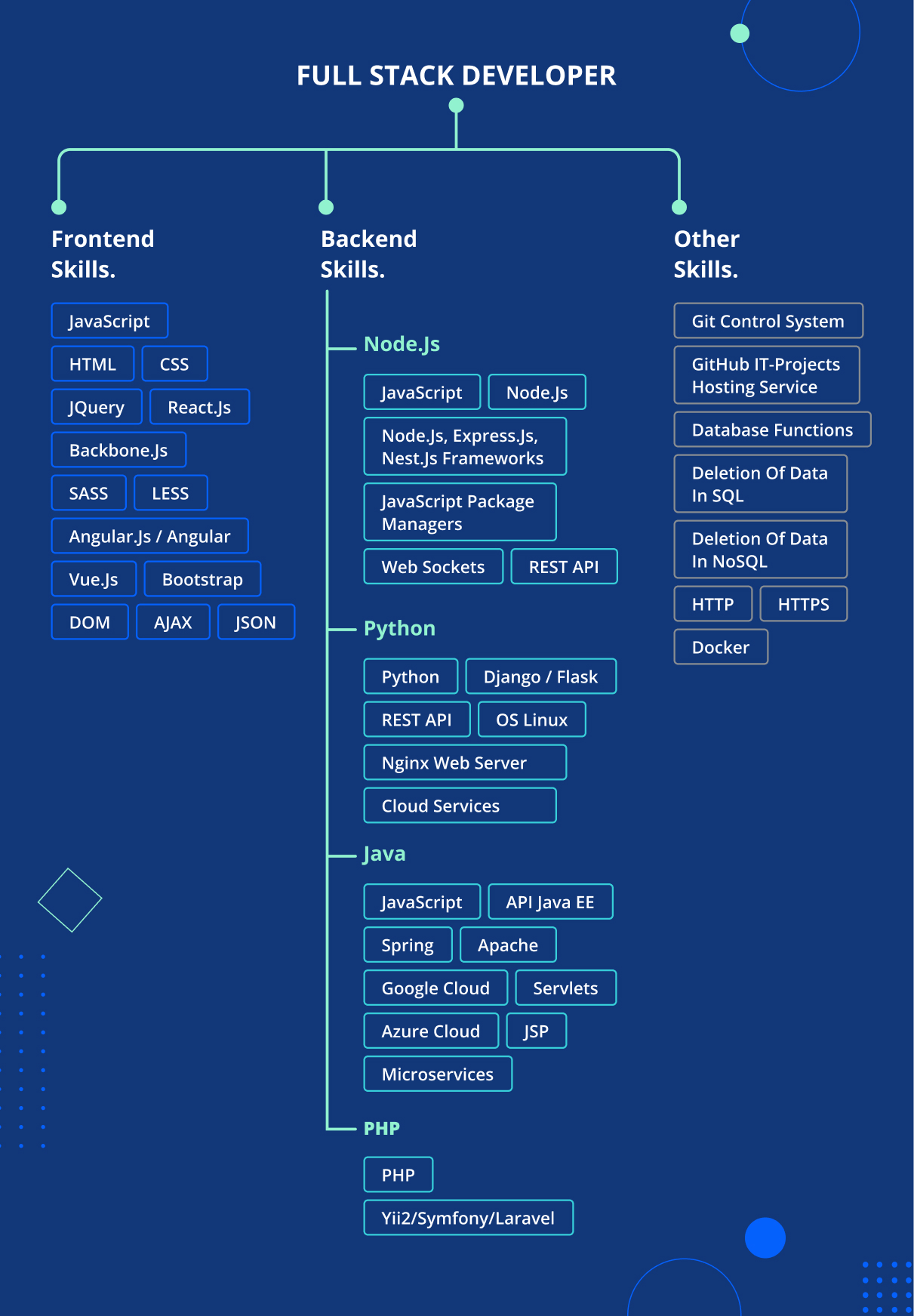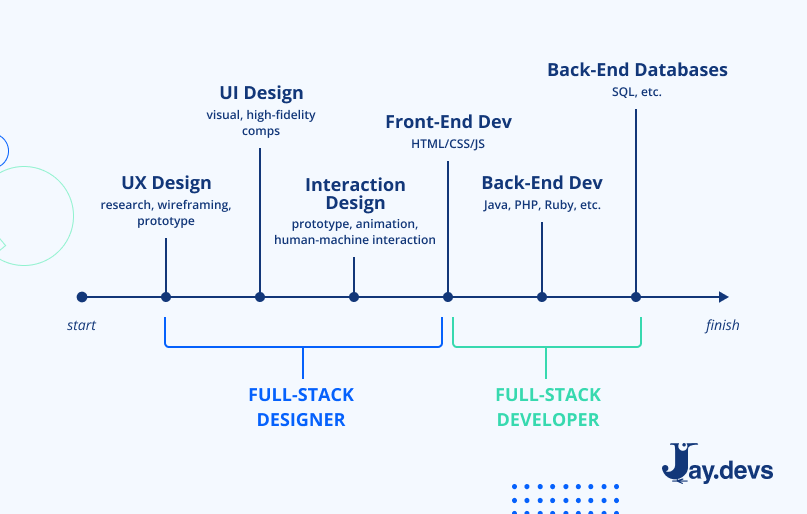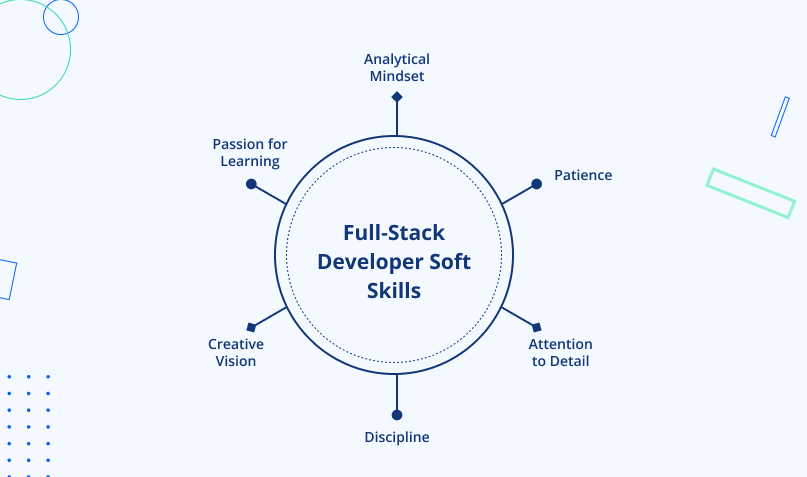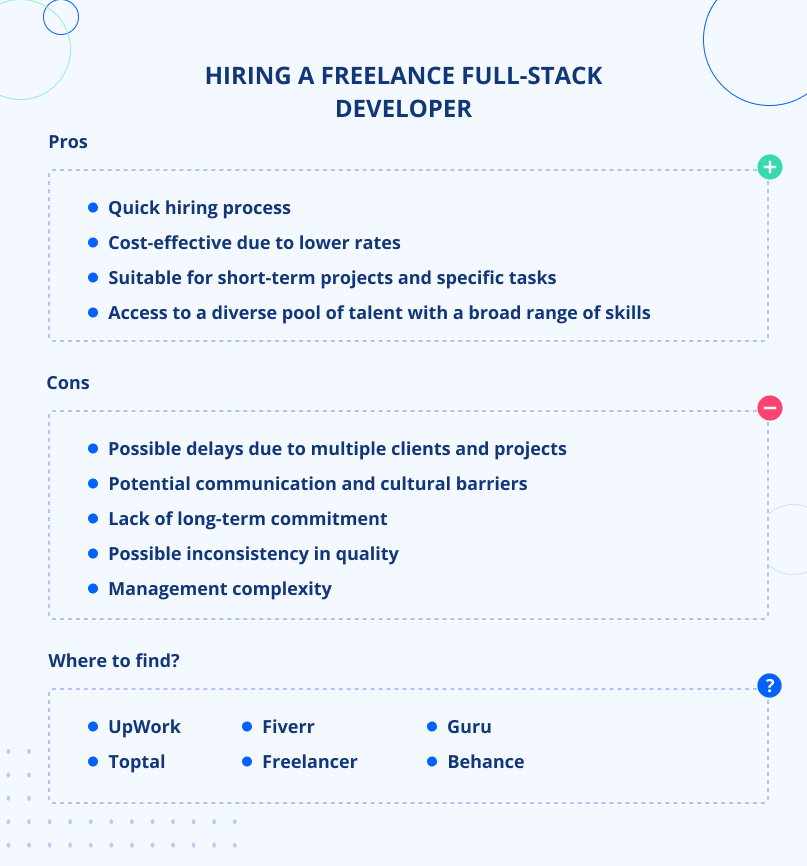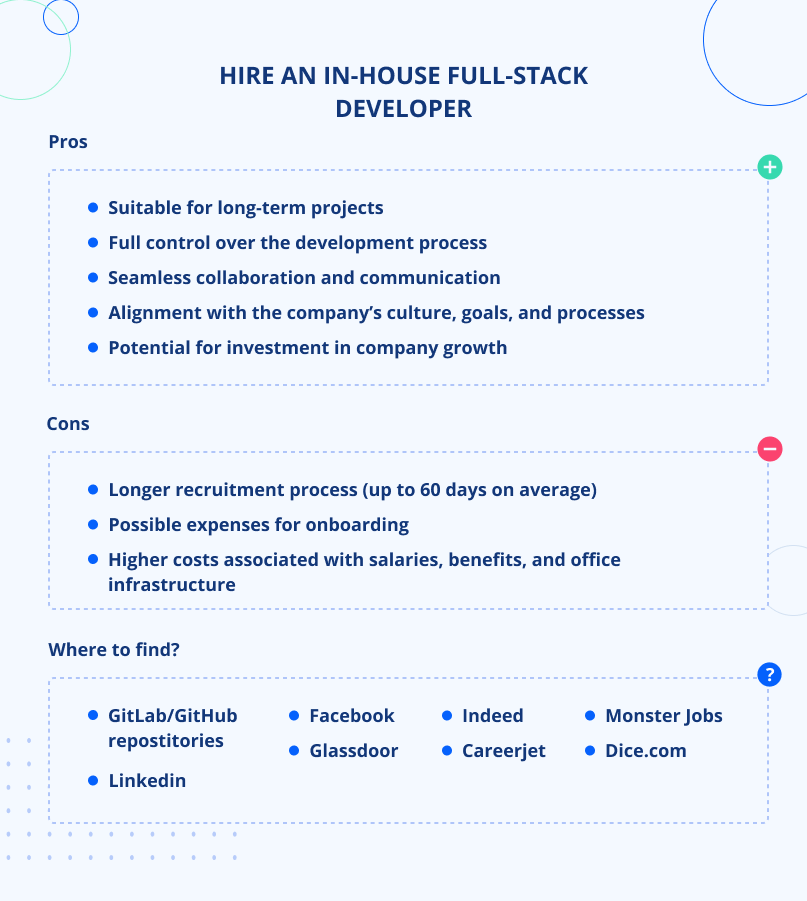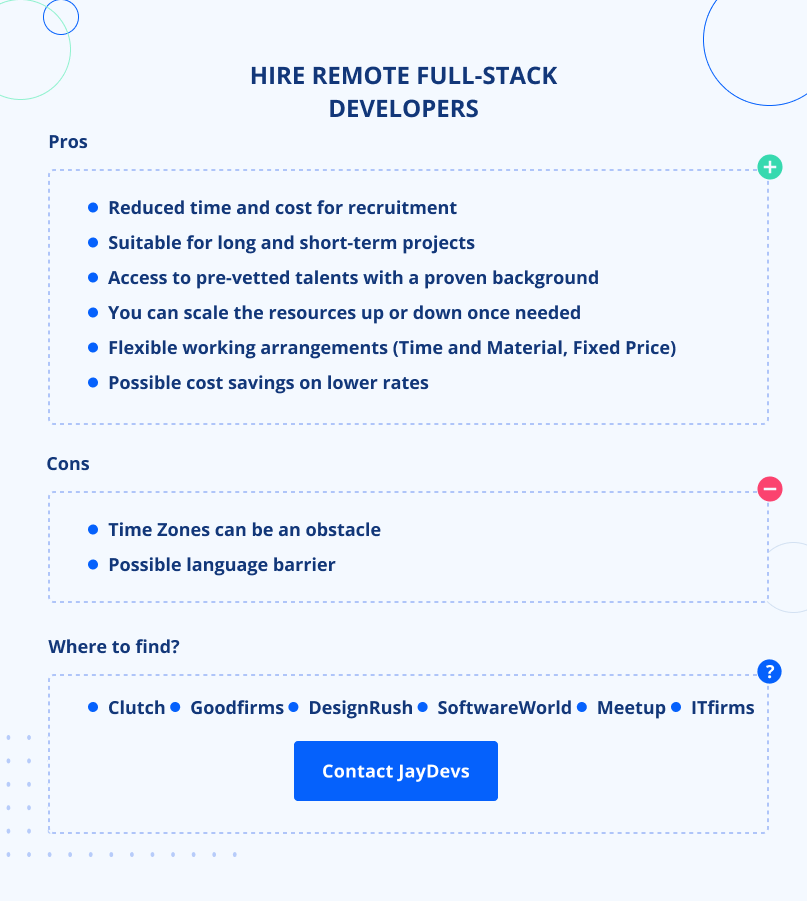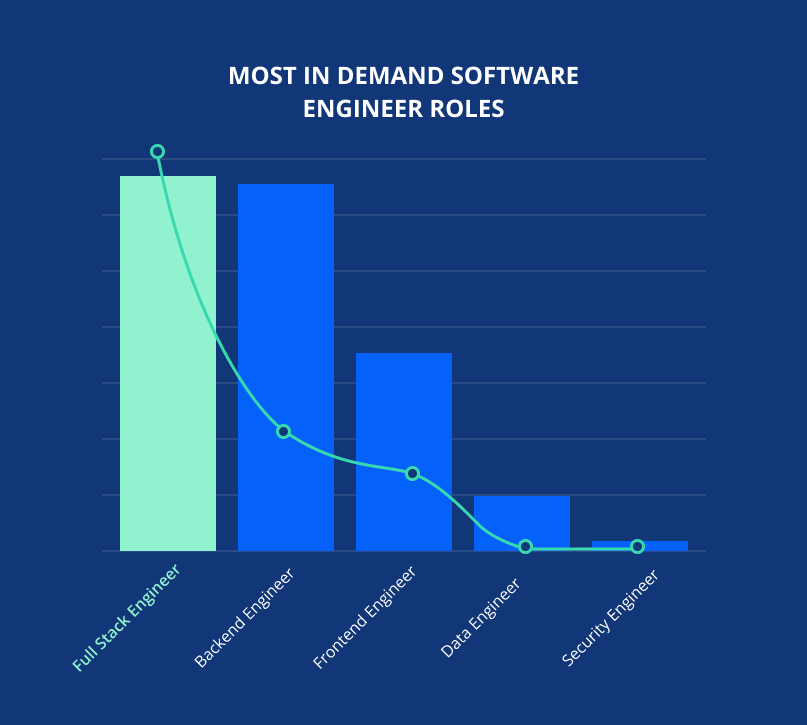By 2012, the term “full-stack developer” began to appear in job descriptions and blog posts. Companies soon discovered that hiring developers with only one language was no longer profitable. Therefore, hiring a full-stack web developer who can solve various tasks was much more useful and was starting to become the new norm.
There are two very contradictory misconceptions when it comes to defining what a full-stack developer is. These are:
- A full-stack developer knows everything, so our company will save on human resources by hiring them.
- A full-stack developer knows a little bit of everything but nothing too specific. A full-stack engineer will only be a burden to our team and will never be able to get into the details the way a frontend or backend developer would.
None of these statements are right or wrong. A full-stack developer is not a wizard who can replace the backend developers and frontend specialists — no. While a full-stack engineer must understand both worlds, their role is to help bring the two groups together. In essence, if you hire a full-stack developer, they’ll be like a bass player in a rock band.
These days, a software development team resembles a rock band. It’s ideal when you have backend and frontend developers covering their respective ends of the spectrum. If the project is well defined, both sides do what they do best, caring little about how the other side does it.
However, as we all know, very few things work perfectly in life. Developers spend most of their time figuring out misunderstandings. They do this during lengthy meetings. If you’ve ever attended such meetings, you know how little respect a front-end specialist will show for detailed suggestions to speed up the backend. That’s the reality. Often, the vision between both sides deviates.
This is where introducing a full-stack programmer to your team can be a huge boost in the productivity of your team and project. A full-stack developer can understand the problems on both sides and translate them into code. This is one of those cases where having a full-stack engineer on your team can make a huge difference.
In this article, we will discuss aspects of how to hire a full stack developer. So, if you are planning to hire best full stack developers for your project, this article will be beneficial.
- 1. Overview of Full-Stack Development
- 2. Growth of the Full-Stack Development Usage
- 3. Why Is Full-Stack Development So Popular?
- 4. Advantages and Challenges of Full-Stack Development
- 5. When Should You Hire Full-Stack Developers?
- 6. What is a Full Stack Developer?
- 7. What Does a Full-Stack Developer Do?
- 8. Essential Skills for a Full-Stack Developer
- 9. Where to Find Full-Stack Developers?
- 10. Full-Stack Developer Interview Questions
- 11. Cost to Hire Full-Stack Developers?
- Sum Up
- Why to Choose JayDevs?
- Hire Full-Stack Developers Easily with Jaydevs
Overview of Full-Stack Development
There are many areas in software development, such as front-end, back-end, mobile development, web, and mobile. There are many areas in software development, such as front-end, back-end, mobile development, web and mobile app testing, and so on. Full-stack developers are highly skilled in the world of web, application, and software development. Best full-stack developers are all-rounders in the programming world. They can juggle multiple technical tasks, which means a complete software development stack: frontend development, backend development, database, APIs, and Version Control Systems.
Growth of the Full-Stack Development Usage
The Bureau of Labor Statistics forecasts an 8% growth of vacancies for web developers and a 22% growth for software developers from 2019 to 2029. Statista, in its turn, reports web development as the most in-demand tech skill worldwide:
As of now, the ability to create and maintain a system from beginning to end or from interface to backend is highly valued.
Therefore, we can confidently say that full-stack developers are in high demand in the labor market. Besides, a 2023 Stack Overflow study of 76,972 engineers globally found that 33.48% identified as full stack.
Why Is Full-Stack Development So Popular and Important?
During contemporary times, full-stack developers often work with much larger and more complex websites and technologies than in the past. While one person can’t always do everything, companies benefit from hiring candidates who understand the full structure. Many companies are looking for developers who can work in different areas and perform multiple roles instead of finding and hiring a few niche professionals. This is more cost-effective and allows one person to manage and understand each part of the project, thereby avoiding misunderstandings and division of knowledge.
Advantages and Challenges of Full-Stack Development for Businesses
Full Stack Development Advantages
Hire Full-Stack Developers to Improve Scalability
One of the first business benefits is the ability of full-stack engineers to work at different levels of software architecture. This makes it easier for clients to build and scale a team of developers for their software development projects. Above all, full-stack developers are used to working in various environments. Consequently, companies that hire full-stack developers should, theoretically, be well-adapted to the ever-changing technology landscape.
All-Round Knowledge of Front-End, Back-End, and Database
Full-stack developers are well versed in the technologies used in client and server-side development, particularly front-end, back-end, and database. This means they can handle the development and testing of, for example, an MVP and later extend it to the final software product.
Hire Full-Stack Developers to Reduce Communication Delays
Hiring a full-stack developer implies that fewer developers will be needed for a project. Accordingly, working with fewer people allows for effective communication with fewer delays and misunderstandings. In addition, when a full stack developer works on a feature implementation, they are often responsible for the entire process, leading to more consistency in collaboration.
Hire Full-Stack Developers to Save Money
Hiring a full-stack developer is the most effective option for businesses with limited budgets who are in search of a reliable and secure solution. This is because full-stack programmers can perform many functions.
Faster Time to Market
Another benefit of full-featured development is that it can help businesses launch products faster. This is useful for businesses operating in a competitive market as it allows them to launch their products faster than competitors.
Full Stack Development Challenges
It’s difficult to evaluate full-stack developers: Recruiters often look at full-stack evaluation in a narrow sense, even though full-stack developers often have specialized front-end or back-end skills, as well as familiarity with other components of app creation. Once your goal is to hire the right full-stack developers, creating individual assessments for the same role may be required, depending on the candidate’s skills and project requirements.
Each project has a different technology stack, so evaluating a full-stack developer requires a high customization level. For example, a full-stack Python developer may sometimes require Django + MySQL, Flask + PostgreSQL, or Django + MongoDB, depending on the framework and database organization.
Unrealistic expectations about hiring a full-stack developer: Suppose a recruiter hires a candidate thinking they can do everything. In that case, the developer may not be suited for the given responsibilities. Conversely, you may inflate expectations for specific technologies, screening out qualified full-stack engineers who may turn out to be weaker in non-primary technologies. That’s why you need to know precisely what skills are required, develop an accurate job description, and tune the interview process.
Slows down the process: Hiring a full-stack developer affects the speed of application development because they won’t work as fast as specialized developers who focus on a single task.
When Should You Hire Full-Stack Development Services?
- When the company is relatively new or small: Full-stack programmers with good experience and knowledge can
- When you need a technical lead: You, as an IT business owner, usually need someone who has extensive knowledge in development, makes sure everything runs smoothly and keeps all elements of the application together. Therefore, an experienced full-stack developer can easily take on the technical leadership role.
- When the company wants to build an MVP: A minimum viable product (MVP) is a version of a product consisting of only the most essential features. Before creating a full application, it is always a good idea to create an MVP to see if the application works the way you expect. By doing so, you can gradually increase the value of the project while eliminating flaws.
Once the company launches the MVP, it will receive feedback from users on what’s missing from the app. Based on this, the company can add those features to subsequent versions of the app. Full-stack developers will prove to be the right choice in terms of cost and timeliness when a company intends to create an MVP. - When constrained by cost: If your budget is limited, hire a full-stack developer. In general, the cost of hiring one front-end and back-end developer can be almost 40% higher than hiring one developer with expertise in both areas. However, you must never compromise on quality and choose the best developers offering full-stack services.
What is a Full Stack Developer?
Full-stack development can be divided into two main components: front-end and back-end development.
Front-End (client): It is everything a site or application user sees and interacts with.
Back-End (server): It is responsible for the logic and processing of user interaction in the application, i.e., user requests and work with the database and API for transferring data. In a nutshell, this is the “brain” of the application.
Together, these two components make up the skill set of a full-stack developer. However, being a full-stack developer does not mean that the programmer has mastered everything required to work with the front-end or back-end. Instead, it means that the developer can work on both sides and understand what happens when building an application.
Types Of Full-Stack Developers
There are different types of software developers, but there are also different types of full-stack developers. Below, you can learn more about the main types of full-stack developers.
MEAN Stack
All components of the MEAN stack support programs are written in JavaScript. Moreover, experts consider MEAN to be the best tech stack for any web development project. It consists of MongoDB (NoSQL DB), Express.js (back-end web framework), Angular (front-end framework), and Node.js (open-source, cross-platform server) and can be used to develop complex web and mobile applications.
MERN Stack
MERN is one of the several variations of MEAN stack, where the traditional Angular framework is replaced by React, a JavaScript library. The MERN stack uses JSX, a modification of JavaScript, and is ideal for creating single-page applications with an interactive user interface. The only drawback is that full stack MERN developers must deal with limited functionality since React is not a framework but a library.
LAMP Stack
LAMP is the old classic industry standard for time-tested web development stacks. LAMP includes Linux (operating system), Apache (HTTP server), MySQL (relational database management), and PHP (programming language). This stack works effectively on all operating systems. When developing websites, it provides the best performance, cost-effectiveness, and flexibility. In addition, its components can be swapped or modified within a single stack.
LEMP Stack
LEMP stack is a collection of Linux OS, Nginx (pronounced ‘Engine X’) Server, MySQL (database), and PHP (programming language). Like Apache’s work in the LAMP stack, Nginx does for the LEMP stack, processing the user requests and responding with suitable output.
Django Stack
Django Stack developer uses the Python stack, which consists of Django, MySQL, HTML, CSS, and Bootstrap. Django is a free, open-source Python framework used for server-side web apps.
Ruby on Rails (RoR) stack
Ruby on Rails is a server-side web application framework written in Ruby. The RoR full-stack developer uses a combination of HTML, CSS, and JavaScript for front-end programming, MySQL or MongoDB for data storage and management, and Rails for back-end development.
What Does a Full-Stack Developer Do?
The day-to-day responsibilities expected from a full-stack developer will vary depending on the project and the experience of the developer. However, looking at job postings for full-stack developers, you’ll notice that many positions share some core responsibilities. These include:
- Creation of front-end and back-end architecture
- Implementation and management of projects by applying certain programming languages
- Testing and debugging, i.e., bug fixing
- Work with databases, cloud storage, and network resources
- API design and development
- Monitoring of web applications and infrastructure performance
Essential Skills for a Full-Stack Developer
A combination of certain skills is required to properly fulfill full-stack developer duties.
1. Front-End Skills
Front-end skills are quite similar for all full-stack developers. These include:
- JavaScript (+ HTML and CSS)
- Libraries such as jQuery, React.js, and Backbone.js
- SASS metalanguage and LESS stylesheet language
- Frameworks such as Angular.js/Angular, Vue.js, and Bootstrap
- DOM, AJAX, JSON technologies
2. Back-End Skills
To be considered a full-stack developer, a specialist should have a general scope of front-end skills and be able to work with the back end. The back-end language is not that important. Instead, it is the platform that matters. For instance, it is important to distinguish the Java platform from the Java language. The Java platform can use different programming languages, i.e., Java, Scala, and Kotlin, but they are all executed in JVM (Java Virtual Machine).
Node.js Full-Stack Developers
Node.js is a system with open-source code that executes JavaScript code outside a web browser. It is not a framework or programming language but a programming platform.
Node developer skills:
- JavaScript Language
- Node.js
- Frameworks suitable for Node.js: Express.js, Nest.js
- Package managers for JavaScript
- Web Sockets and REST API
Python Full-Stack Developers
Python – A universal programming language for everything, starting from educational tasks and up to working with neural networks.
Python developer skills:
- Python programming language
- Django/Flask framework
- REST API
- OS Linux and Nginx web server
- Cloud services
Java Full-Stack Developers
Java is one of the most popular programming languages. It is functional on plenty of operational systems for various processors. Java components are easily accessible, and there are no issues with ready solutions.
Java full-stack developer skills:
- JavaScript language
- API Java EE specification
- Spring (Spring MVC, Spring Boot, Spring REST, Spring Web) Framework
- HTTP-server Apache
- Google Cloud and Azure Cloud services
- Servlets, JSP, and microservices
PHP Full-Stack Developers
PHP – It is a server scenario language created especially for web development. It is handy when creating templates, and themes and expanding standard HTML possibilities.
PHP developer skills:
- PHP language
- Framework Yii2/Symfony/Laravel
3. Basic Design Skills
Full-stack developers need fundamental design strategy skills to create attractive and user-friendly websites. Basic web design principles include UI/UX design and its prototypes.
4. Git and GitHub Experience
Git, a popular version control system, allows developers to handle every step of the software development process. Its bug fixing and tracking efficiency compare favorably to other control systems.
GitHub is a platform that allows full-stack web developers to work and manage many projects simultaneously. As the name implies, it creates a hub for communication and interaction with other developers. GitHub uses git features to provide an ideal platform for developers.
5. Databases and Web Storage
Almost all websites have a database in which all application data is stored. For example, if you have an e-commerce site, this will carry data about your products and users.
Part of the full-stack developer’s skill is the ability to write queries to call up the right data on the site when needed. Knowing the data structures is also useful here. This way, data is stored so that it can be queried in the most efficient way possible. Working with database functions such as storage, creation, control, processing, and deletion of data is an important part of the job.
The two main types of databases are SQL (relational) and NoSQL (non-relational). A popular NoSQL database service is MongoDB.
6. HTTP and REST
The Hypertext Transfer Protocol (HTTP) is the basis for data transfer on the Internet, such as loading webpages, streaming videos, and other forms of communication between web browsers and web servers. It’s the basis of most of our everyday interactions on the Internet. HTTP enables communication between web clients and web servers through requests and responses.
Representative State Transfer (REST) is an architectural standard. It makes it easy for computer systems to communicate with each other. RESTful systems use HTTP to collect data and perform various operations. REST provides communication between the front end and back end.
7. Soft Skills
If you hire a full-stack developer, you should also understand whether they have the necessary personality characteristics to handle the job. For example, a talented full-stack developer should have the following soft skills:
Where to Find Full-Stack Developers?
Model #1: Hire a Freelance Full-Stack Developer
Freelance full-stack developers are self-employed engineers who work remotely. You pay them their set rates without additional costs while assigning tasks to the extent you require.
Pros of Hiring a Freelance Full-Stack Developer
- Quick hiring process
- Cost-effective due to lower rates
- Suitable for short-term projects and specific tasks
- Access to a diverse pool of talent with a broad range of skills
Cons of Hiring Freelance Full-Stack Developers
- Possible delays due to multiple clients and projects
- Potential communication and cultural barriers
- Lack of long-term commitment
- Possible inconsistency in quality
- Management complexity
Best Platforms for Finding Freelance Full-Stack Developers
Some of the most popular platforms to look for freelance full-stack developers:
- UpWork
- Toptal
- Fiverr
- Freelancer
- Guru
- Behance
Model #2: Hire an In-House Full-Stack Developer
Hiring in-house full-stack engineers usually involves recruiting local talents so you can arrange offline meetings and discussions. Hiring in-house app developers is costly, yet it is a better option for long-term and sophisticated projects.
Pros of Hiring an In-House Full-Stack Developer
- Suitable for long-term projects
- Full control over the development process
- Seamless collaboration and communication
- Alignment with the company’s culture, goals, and processes
- Potential for investment in company growth
Cons of Hiring an In-House Full-Stack Developer
- Longer recruitment process (up to 60 days on average)
- Possible expenses for onboarding
- Higher costs associated with salaries, benefits, and office infrastructure
Best Platforms for Finding an In-House Full-Stack Developer
You can look through job boards on GitLab and GitHub repositories and hire full-stack developers who match your business needs. Another good option is to publish a job posting on Linkedin, as well as on job board sites like:
- Glassdoor
- Indeed
- Careerjet
- Monster Jobs
- Dice.com
Model #3: Hiring Full-Stack Developers through Tech Recruiting Services
Tech recruiting services specialize in connecting businesses with highly skilled IT professionals, including full-stack developers. Instead of managing the hiring process in-house, businesses can outsource this task to recruitment agencies or platforms that specialize in sourcing, screening, and matching candidates with the right skills and experience.
Pros of Hiring Full-Stack Developers through Tech Recruiting Services
- Access to a Vast Talent Pool
- Time and Cost Savings
- Expertise and Industry Knowledge
- Efficient Screening Process
Cons of Hiring Full-Stack Developers through Tech Recruiting Services
- Limited Control
- Quality Variability
Best Platforms for Finding Full-Stack Developers through Tech Recruiting Services
- GoodFirms
- Clutch
- JayDevs
Model #4: Hire Remote Full-Stack Developers
Hiring remote developers is a go-to option to quickly augment your existing team with one or several external engineers. By engaging with staff augmentation vendors, you have the opportunity to recruit highly skilled developers with specific expertise. Once hired, remote developers seamlessly integrate into your team, become its full-fledged part, and structure their work according to your requirements.
Pros of Hiring Remote Full-Stack Developers
- Reduced time and cost for recruitment
- Suitable for long and short-term projects
- Access to pre-vetted talents with a proven background
- You can scale the resources up or down once needed
- Flexible working arrangements (Time and Material, Fixed price)
- Possible cost savings on lower rates
Cons of Hiring Remote Full-Stack Developers
- Time zones can be an obstacle
- Possible language barrier
Best Platforms for Finding Remote Full-Stack Developers
To hire remote developers, you can reach out to staff augmentation companies, describing the particular expertise your project requires. You can find such vendors via directories, listings, or personal references.
Or, you can contact JayDevs: we have a diverse tech talent pool, who passed a rigorous vetting process. We focus on aligning the needs of our clients with engineering expertise, providing the right full-stack developers and other specialists.

Full-Stack Developer Interview Questions
In terms of seniority, developers are divided into three categories: Junior, Middle, and Senior full-stack developers. The developers’ level provides insight into their tech skills and salary.
Traditionally, an interview is split into two parts. The first part includes theoretical questions; the second is a practical task.

This module covers only the first stage of the interview — technical questions.
For more understanding, we split questions into the front-end and back-end parts and listed a couple of possible questions. A more exhaustive list can be found on GitHub.
Front-End Related Questions
- CSS question. What’s the difference between an id and a class?
- HTML question. Can an HTML element have multiple classes?
- JS question. What is the difference between a load and DOMContentLoaded events?
For more front-end questions, click here and here.
Back-End Related Questions
Node.js Full-Stack Developer Interview Questions
- Junior level. Is it possible to run a Node process without V8?
- Middle level. How can we avoid callbacks?
- Senior level. What is the difference between process.nextTick() and setImmediate()?
Python Full-Stack Developer Interview Questions
- Junior level. What does «self» mean in Python?
- Middle level. What is the difference between remove, del, and pop?
- Senior level. What is an example of a file processing mode in Python?
Java Full-Stack Developer Interview Questions
- Junior. How does Java provide high performance?
- Middle. What is the difference between override vs. overload?
- Senior. Can Enum extend a class?
PHP Full-Stack Developer Interview Questions
- Junior level. What are the three visibility fields for variables in PHP?
- Middle level. What is the difference between while and do-while cycles?
- Senior level. There is an array[1,2,3,4,5,6,7]. What should be done to reverse it and get [7,6,5,4,3,2,1]?
Additional questions for back-end developers can be found here.
Cost to Hire Full-Stack Developers
Salaries for full-stack developers can vary depending on several factors, including experience level, technical stack, and location.
We have compiled a comparison of average developer salaries across various countries, categorized by seniority levels. This information will help you align your budget expectations with the most suitable hiring location.
The data is based on Talent.com, ZipRecruiter, Indeed, and Glassdoor figures. Please note that these estimations are approximate and can vary based on such factors as specific technical skills.
Annual Salary of MEAN Stack Developers
The average salaries for developers experienced in AngularJS and Node.js are as follows:
Annual Salary of MERN Stack Developers
The average salaries for professionals experienced in React and Node.js are roughly comparable with MEAN specialists:
Annual Salary of LAMP & LEMP Stack Developers
Technicians, who work with web architecture using PHP, MySQL, Apache/Nginx, generally earn less:
Annual Salary of Django Stack Developers
Tech specialists who are working with Python and Django are among the most highly paid:
Annual Salary of RoR Stack Developers
Similar to Django devs, RoR stack developers are highly paid particularly due to a smaller development pool compared to other stacks:
Sum Up
Hiring a full-stack developer in 2024 will not be easy, as qualified talents are in high demand. However, selecting potential candidates is not frightening when you understand where effort and attention should be directed.
We hope the information in this article helped you better understand how to hire a full-stack developer for your project.
Feel free to contact us if you plan to hire a full-stack developer. Our company has gathered a great pool of highly qualified senior developers.
Why You Should Select JayDevs to Hire Skilled Full-Stack Developers?
Hiring top-notch software engineers for your project is often stressful. Therefore, you need to find the right candidate the first time. This would mean smart, responsible, and experienced developers, or you’ll have trouble getting your project up and running.
JayDevs can solve all your hiring problems by matching you with programmers who have a complete knowledge stack. Our goal at JayDevs is to offer you a programmer who will quickly and efficiently fit into your team and help develop your project.
93% of our team members are senior engineers with proven technical knowledge and good communication skills. We are trusted by many fast-growing startups. Therefore, hire your next full-stack developer with JayDevs, and you can start full development in as little as a week.
There are plenty of disturbing reviews of contractors who abandon a project halfway through or freelance full-stack developers who suddenly disappear, thereby leaving you stranded. Jaydevs supports you with our top-notch developers under all the rules of the contract developer hiring system. In other words, we’ll provide you with the perfect full-stack developer.
Compare Hiring Full-Stack Developers with JayDevs to Upwork, Toptal, and In-House
The perfect candidate can be hard to find, and the longer the hiring process takes, the slower it takes to scale your business.
JayDevs saves you money and time. If you’re still in doubt, take a look at the summary table below:
Hire Full-Stack Developers Easily with Jaydevs
Step 1: Discuss Your Business Needs with Our Manager
Fill in the form and book a call to schedule a time to speak with one of our account specialists. We’ll ask you about the project, your requirements, and your expectations for a developer. After you have spoken with our account manager, we will review our developer talent pool and select a few candidates for you with whom you can have a more in-depth interview.
Step 2: Begin Interviewing
After we send you the list of developers, we’ll help you set up a time for an interview and meeting with the developers via video conference. This way, you can determine if the full-stack developer qualifies for your project.
If you feel like you’re on the same page as your selected full-stack developer, you can start organizing work activities and signing a contract.
